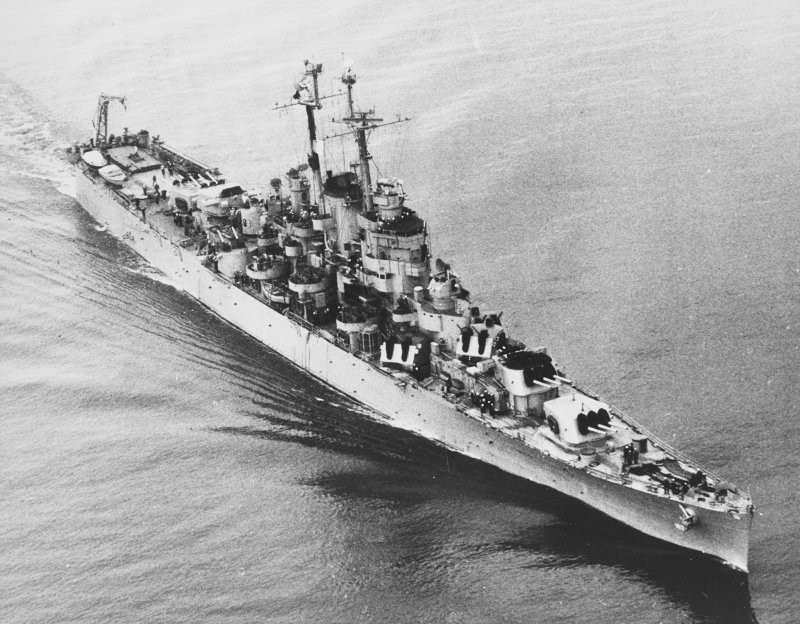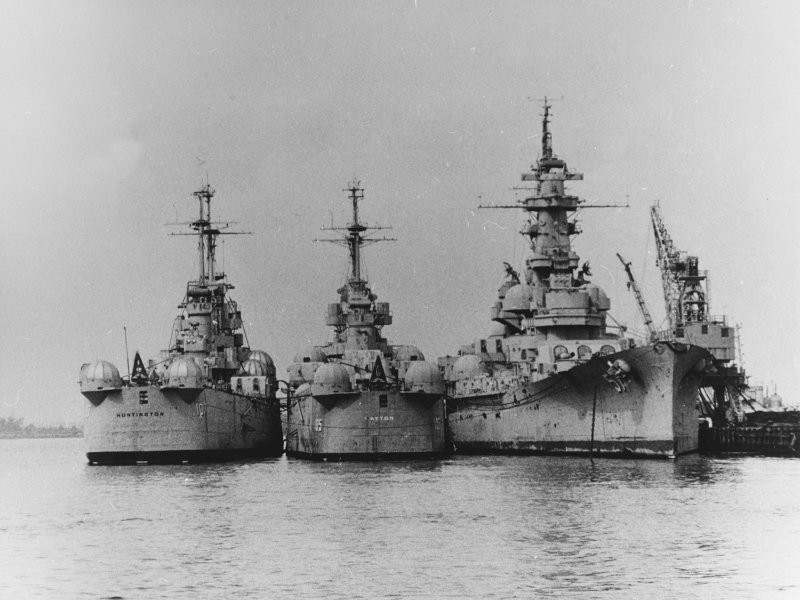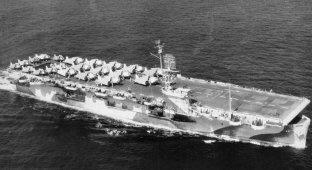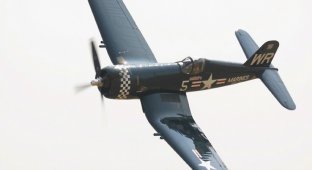Fargo. American cruisers are out of season (5 photos)
It happens that new and more advanced technology compared to previous models becomes a victim of circumstances. Instead of logically active use, it stands idle while the less perfect, but proven one continues to serve. A striking example of this can be the history of Fargo-class cruisers, which, although they plied the seas, but only on “courtesy visits”, never meeting the enemy. 
Fargo-class cruiser, 8 May 1946
The circumstances of World War II in the Pacific Theater were such that the US Department of the Navy was forced to speed up the construction of new ships based on already developed projects, even if not all of them were of high quality. Cleveland-class cruisers were built quickly and in large numbers, but there were also enough problems with them: stability, overload, cramped conditions, weak air defense and armor - all this was a headache for both the sailors and the command.
It is not surprising that the design of a cruiser that would combine the positive characteristics of the Cleveland class and would be free from its disadvantages began soon. The designers relied on numerous reviews from the Navy about the “predecessors” and their combat experience, and therefore development proceeded quickly.
Unlike its predecessor, the Fargo was supposed to lower the main caliber turrets by a foot, as well as move some of the onboard 127 mm guns and 40 mm anti-aircraft guns to the main deck. In addition, the boiler rooms were moved in order to bring all the chimneys into one pipe - this was necessary to give the superstructure a pyramidal shape, which in turn was supposed to improve the pointing angles of air defense guns. The aft aircraft hangar was halved, and crew quarters were installed in the vacated space to improve the living conditions of sailors who experienced such problems on Cleveland-class ships.
The main belt armor of the new type of cruisers was almost identical to the Cleveland type - 127 mm. However, the Fargo's total armor weight was almost 100 tons more. Otherwise, the differences were minimal - from armor to weapons and power plant.
The Fargo type was as follows: standard displacement - 11,744 tons, gross displacement - 14,464 tons, length was 185.3 m, beam 20.2 m and draft - 6.7. Power plant with a capacity of 100,000 hp. worked on steam generated by four Babcock & Wilcox boilers at a temperature of 454 ° C and a pressure of 39.7 kg/cm². Four geared steam turbines from General Electric drove four propellers, which allowed it to reach a speed of 32.5 knots.
Armament consisted of 4x3 152mm/47 main and 6x2 127mm/38 auxiliary caliber guns, and anti-aircraft artillery consisted of 4x4 and 6x2 40mm/56 Bofors guns and 20 single 20mm autocannons Oerlikon. In addition, there were four seaplanes on board. As part of the US Navy, these ships were considered light cruisers, although, according to international agreements, they could not be classified as such due to their displacement.
It was planned to build 13 units. The first ship, USS Fargo (CL-106), was laid down on August 23, 1943 at the New York Shipbuilding Corporation shipyards in Camden. It was followed by the laying of eight more ships at the same shipyards, as well as at William Cramp & Sons in Philadelphia and Newport News Shipbuilding and Dry Dock in Newport News, Virginia. 
Fargo in reserve, circa 1965
However, the war was ending, and already on October 5, 1944, the order for four ships that had not yet been laid down was canceled, and on August 12, 1945, the cancellation of those under construction followed. By that time, 3 cruisers had been launched and were being completed: Fargo, Huntington (CL-107) and Newark (CL-108). The latter, 67.8% complete, was not completed, deciding to use it for testing, after which it was sold for scrap in April 1949.
Fargo was commissioned on December 9, 1945, but only on April 15, 1946 it left Philadelphia on a campaign, visiting Bermuda, Trinidad, Rio de Janeiro and Montevideo, from where on May 31 it entered the Mediterranean Sea, where it stopped at the ports of Turkey, Lebanon, Greece, Italy, France and North Africa. On March 2, 1947, he returned to New York, but on May 20 he sailed again to the Mediterranean, where for a month he was the flagship of the commander of the Mediterranean squadron of the US Navy.
After returning to Newport, the cruiser was included in the forces that participated in exercises in October-November 1947 and was the flagship of Vice Admiral Redford. Over the next two years, Fargo visited the Mediterranean twice and participated in maneuvers twice, after which she was put into reserve on February 14, 1950 and laid up in a small town in New Jersey. 
Huntington, April 12, 1948
There it sat for 20 years until it was finally removed from the fleet on March 1, 1970 and sold for scrap to the local Union Minerals and Alloys Corporation.
As for the USS Huntington (CL-107), it was commissioned on February 23, 1946. After small training maneuvers at Guantanamo, he departed for the Mediterranean on June 23, where he became part of the 6th Fleet. Then the cruiser repeatedly returned to the shores of America for maneuvers near Cuba and Newfoundland. After another period in the Mediterranean, the Huntington passed through the Suez Canal in September 1948 and began making “courtesy visits” to African and South American ports - in particular, Buenos Aires and Montevideo were visited in November, where the Argentine and Uruguayan presidents, respectively, came aboard .
On December 8, 1948, Huntington returned to the United States, but later again briefly went to the Caribbean, after which she returned to Newport on January 22, 1949, where she was put into reserve and laid up on June 15. Without ownership, it was worth less than a sistership: already on September 1, 1961, it was excluded from the fleet lists and the next year it was sold for scrap to Boston Metals. 
Huntington in reserve (far left). Next to it in the center is the cruiser USS Dayton (CL-105), on the right is the battleship USS South Dakota (BB-57). August 24, 1961
Thus ended the service of the Fargo class cruisers. Although one could say that it practically never began - both ships were used for less than five years, and then only on maneuvers, and most of all for visiting foreign ports. Much more advanced than their predecessors, these cruisers did not get the opportunity to demonstrate their capabilities, and ingloriously stood in ports until they were cut to pieces.























